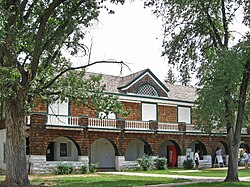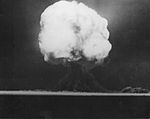Fort Stanton
Fort Stanton | |
 Adjutant Office in 2009 | |
 | |
| Location | 7 mi. SE of Capitan near U.S. 380 |
|---|---|
| Nearest city | Capitan, New Mexico |
| Coordinates | 33°29′40″N 105°31′35″W / 33.49444°N 105.52639°W / 33.49444; -105.52639 |
| Area | 195 acres (79 ha) |
| Built | 1855 (1855) |
| Architectural style | Colonial Revival, Mission/Spanish Revival |
| NRHP reference No. | 73001142 (original) 99001679 (increase) |
| NMSRCP No. | 60 |
| Significant dates | |
| Added to NRHP | April 13, 1973 |
| Boundary increase | January 14, 2000 |
| Designated NMHS | August 9, 2007[1] |
| Designated NMSRCP | May 23, 1969 |
Fort Stanton was a United States Army fort near Lincoln, New Mexico.
Army Fort

It was built in 1855 by the 1st Dragoon and the 3rd and 8th Infantry Regiments to serve as a base of military operations against the Mescalero Apaches. Numerous campaigns were fought from 1855 until the 1880s.[2] It was established to protect Hispano and White settlements along the Rio Bonito in the Apache Wars. Kit Carson, John "Black Jack" Pershing, Billy the Kid, Pat Garrett, and Buffalo Soldiers of the 9th Cavalry all lived here.[3][4][5][6]
Confederate forces occupied the outpost in 1861, at the beginning of the American Civil War. This U.S. military fortification was abandoned with the withdrawal of U.S. forces in 1896.[7]
The fort was originally established in part as the Mescalero Apache reservation. In 1873 the reservation was moved 30 miles southwest to its current location.[8][9]
Marine Hospital

In 1899, President William McKinley transferred Fort Stanton property from the War Department to the Marine Hospital Service, converting the military reservation to America's first federal tuberculosis sanatorium.[8][9]
During World War II, Fort Stanton was used as a detention center for German and Japanese Americans arrested as "enemy aliens," and 411 German nationals taken from the luxury liner Columbus in 1939 (officially recorded as "distressed seamen paroled from the German Embassy" since the U.S. was still technically neutral at the time of their capture).[10][11] The "enemy aliens" were mostly immigrant residents of the U.S. who had been taken into custody as suspected saboteurs shortly after the U.S. entered the war, despite a lack of supporting evidence or access to due process for most internees. The 31 German American internees, labeled "troublemakers" by the Department of Justice, were kept separate from the 17 Japanese Americans (also deemed "troublesome" by authorities) who were transferred to Fort Stanton on March 10, 1945. These new arrivals were deported to Japan later that year.[12]
The hospital was closed in 1953.[13]
Later history
In 2008, New Mexico governor Bill Richardson announced plans to establish Fort Stanton as a living history venue, Fort Stanton State Monument, and funds to renovate headquarters, officers quarters, and stables.[14]
In 2009, the area around Fort Stanton and Fort Stanton Cave was designated by the U.S. Congress as a National Conservation Area (NCA), with more than 25,000 acres in order to protect a unique cave resource, Snowy River Passage in Fort Stanton Cave National Natural Landmark. Snowy River was discovered in 2001 by members of the Fort Stanton Cave Study Project. The new NCA, called Fort Stanton – Snowy River Cave, is managed by the Bureau of Land Management, Roswell Field Office. The NCA has over 90 miles of multi-use trails for horseback riding, mountain bike riding and hiking. It is the venue of an annual endurance riding event that has grown to be 6 days long. The NCA is joined on its south and northeast boundaries by the Smokey Bear Ranger District of the Lincoln National Forest.
In 2012, members of the Southwestern Region of the National Speleological Society completed a restoration project on the second floor balcony of Building #9, located on the Fort Stanton Quadrangle.
In 2019, a team from AmeriCorps National Civilian Community Corps along with Fort Stanton Staff renovated and restored Fort Stanton's Hidalgo Building into a volunteer dormitory, began restoration on the historic school house, restored an original TB Hut, and expanded the hospital's current exhibit to include two new exhibits.
See also
- Escape from Fort Stanton
- Ruidoso, New Mexico
- Capitan, New Mexico
- Lincoln National Forest
- Battle of Mesilla (disambiguation)
- Gallinas Massacre
- National Register of Historic Places listings in Lincoln County, New Mexico
References
- ^ "Fort Stanton Historic Site History". New Mexico Department of Cultural Affairs. Retrieved December 22, 2016.
- ^ Garland, John (1856). "Reports From The Department Of New Mexico To The Secretary Of War (May 31, 1855, Jno Garland)". Executive Documents of the Senate of the United States, First and Second Sessions, Thirty-Fourth Congress. 2 (1). Washington DC: A.O.P. Nicholson: 70–71. Retrieved May 2, 2012.
- ^ Sabin, Edwin L. (1914). Kit Carson Days (1809-1868). Chicago IL: A. C. McClurg & Co. pp. 413–417.
- ^ MacAdam, George (January 1919). "The Life of General Pershing". The World's Work. XXXVII (3). New York, NY: Doubleday, Page & Co.: 281–293. Retrieved May 2, 2012.
- ^ Garrett, Pat Floyd (1882). The Authentic Life Of Billy, The Kid (on Wikipedia). Santa Fe, NM: New Mexican Printing and Publishing Co.
- ^ U.S. House of Representatives, Committee on Military Affairs (1874). Proposed Reduction Of The Military Establishment. Washington DC: Government Printing Office. pp. 7–8.
- ^ "The Confederate Invasion Of New Mexico: 1861-62". Old Santa Fe. III (9). Santa Fe NM: Old Santa Fe Press: 5–43. January 1916. Retrieved May 2, 2012.
- ^ a b "National Care of Consumptives". Medical Review of Reviews. V (4): 294–295. April 25, 1899. Retrieved May 2, 2012.
- ^ a b "Government Sanatoria In New Mexico". The Medical Dial. 1 (13). Minneapolis MN: 377. December 1899. Retrieved April 29, 2012.
- ^ "Interns At New Camp", St. Joseph News-Press, p. 8, March 18, 1941, retrieved May 4, 2012
- ^ J. Burton, M. Farrell, F. Lord, R. Lord. Confinement and Ethnicity: An Overview of World War II Japanese American Relocation Sites, "Department of Justice Internment Camps: Fort Stanton, New Mexico" Archived 2015-04-14 at the Wayback Machine (National Park Service) Retrieved 13 Jun 2014.
- ^ "Fort Stanton" Densho Encyclopedia. Retrieved 13 Jun 2014.
- ^ "United States. Public Health Service. Division of Hospitals". SNAC. Retrieved 2020-08-31.
- ^ "Governor Richardson Announces Fort Stanton Renovations" Archived 2008-12-03 at the Wayback Machine (PDF). Press Release, May 9, 2008.
Further reading
Sanitarium
- Cobb, J. O. (December 1899). "The Arid Region Of The United States For Consumptives". The Sanitarian. 43 (361). New York NY: The Medico-Legal Society Of New York: 501–511. Retrieved May 2, 2012.
- Cobb, J. O. (December 1900). "The Sanitarium for Consumptive Sailors Established: The U.S. Marine Hospital Service At Fort Stanton, N.M." Gaillard's Medical Journal. LXXIII (6): 290–296. Retrieved May 2, 2012.
- Huber, John Bessner (1906). Consumption: Its Relation To Man And His Civilization. Philadelphia PA: J. B. Lippincott. pp. 265–274. Retrieved May 2, 2012.
- Newman, Oliver P. (July 1904). "Government Care Of Consumptives". The American Monthly Review of Reviews. XXX (1): 59–64. Retrieved May 2, 2012.
- Reed, Alfred C. (April 1913). "United States Public Health Service". Popular Science Monthly. LXXXII (4). New York NY: The Science Press: 353–375. Retrieved May 2, 2012.
- Rosenau, R. J. (1900). "Report on the Work of the Marine Hospital Service at Fort Stanton, New Mexico". The Medico-Legal Journal. XVII (4). New York NY: The Medico-Legal Society Of New York: 504–508. Retrieved May 2, 2012.
- "Marine Hospital Sanatorium, Fort Stanton, New Mexico". The Modern Hospital. X (1): 7–9. January 1918. Retrieved May 2, 2012.
World War II Internment Center
- Anderson, William E. (1993). Guests for the Duration, World War II and the Crew of the S.S. Columbus: Historical Archaeological Investigation of the Fort Stanton Internment Camp (1941-1945). Eastern New Mexico University.
- Fiset, Louis (Spring 2001). "Return to Sender: U.S. Censorship of Enemy Alien Mail in World War II". Prologue Magazine. 33 (1). Washington DC: National Archives and Records Administration. Retrieved May 2, 2012.
- McBride, James J. (1996). Interned: Internment Of The SS Columbus Crew During World War II. University of New Mexico.
- "Fort Stanton (detention facility)", Densho Encyclopedia, April 1, 2013
- "Stores and Germans "Sever Relations"", Spokane Daily Chronicle, p. 7, April 29, 1941
- "Chief Of Interned Men Threatens To Move "Business"", The Victoria Advocate, p. 1, April 29, 1941
- "Posse Recaptures Fugitive Germans: Ranchers and Cattlemen Round Up Quartet From New Mexico Camp", The Montreal Gazette, vol. CLXXI, no. 264, p. 20, November 4, 1942
- "Kuhn Goes On Hunger Strike: Increased Recreational Facilities Sought", The Telegraph-Herald, p. 9, August 30, 1944
External links

- Friends of Fort Stanton historical page
- Fort Stanton, Lincoln County New Mexico
- American Southwest, a National Park Service Discover Our Shared Heritage Travel Itinerary
- AERC.org: Fort Stanton Cave (slideshow)
- v
- t
- e
- Portland
- Staten Island
- Neponsit Beach
- Ellis Island
- Freedmen's Hospital (D.C.)
- St. Elizabeths Hospital (D.C.)
- Charleston

- Mobile
- Nassau Bay
- Fort Worth
- Paducah
- Louisville
- Cincinnati
- Lexington
- Pittsburgh
- Detroit
- Seattle
- San Francisco
- Fort Stanton
- Lahaina














